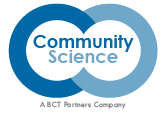As one of the largest volunteer networks in the U.S., the Corporation for National & Community Service (CNCS) Senior Corps Retired and Senior Volunteer Program (RSVP) aims to engage volunteers aged 55 and over to support disaster preparedness, response, and recovery, and increase community resiliency. In 2013 and 2014, CNCS provided Disaster Services Augmentation Grants for several RSVPs. These grants focused on addressing the 2014 Hurricane Sandy recovery in New York and a range of disasters that happened in 2013, including floods in northern Colorado; a flash flood in Waynesville, Michigan; a tornado in Moore, Oklahoma; and a fertilizer plant explosion in West, Texas. In the aftermath of disaster, RSVPs deployed thousands of volunteers who played key roles in various activities such as developing disaster preparedness kits, operating volunteer reception centers and call centers, performing direct outreach to disaster victims, rebuilding homes, and managing donation centers.
Community Science used a cross-case study design to conduct site visits rooted in a community resilience framework (see the article “Putting Community into Community Resilience” above in this issue) to understand the history, accomplishments, impacts, and lessons of the RSVP Disaster Services Augmentation Grants. Site visits provided an opportunity to gather feedback from a total of 90 RSVP staff, CNCS staff, volunteers, partner organizations, affected stakeholders, and service beneficiaries through interviews and focus groups.
One key way in which RSVPs increased community resilience was by helping community members access needed services and supports as well as by addressing gaps in service provisions in the aftermath of disasters, particularly for vulnerable populations. For example, following disaster events in both Colorado and Oklahoma, RSVPs experienced a rise in requests for transportation services due to the impacts of the disaster (e.g., damage to roads); therefore, RSVPs in
Colorado and Oklahoma provided people with disabilities and seniors with transportation to medical appointments and to pick up prescriptions. RSVPs in Texas and Oklahoma served and delivered meals to vulnerable seniors in support of local disaster response and recovery efforts. Some RSVPs also developed new services and programs to address local disaster-related issues. For example, the New York RSVP led a phone-banking initiative to assess resident needs when they found that major recovery issues had still not been addressed one year following Hurricane Sandy, particularly in regard to the home-rebuilding process. The data collected through phone banking shaped the local long-term recovery organizations’ strategic planning to ensure all residents’ needs were met. A number of grantees also used funds to strengthen community infrastructure, making their communities more resilient by engaging in disaster preparedness initiatives. For example, RSVPs in Missouri, Oklahoma, and Colorado developed disaster preparedness kits and tailored preparedness trainings to vulnerable community members such as children, residents in rural communities, and seniors.
The evaluation also examined several challenges RSVPs faced supporting disaster preparedness and recovery, including a lack of previous disaster response experience among both RSVPs and other organizations in the communities they worked in, difficulties determining the roles of RSVP volunteers, and insufficient coordination with other organizations and agencies at the local and regional level. Based on study findings, Community Science provided recommendations for developing a technical assistance toolkit to help bolster the capacity of future grantees to strengthen their communities in the aftermath of disasters. Recommendations provided guidance to RSVPs on communication about the role of RSVP and its volunteers in conducting essential disaster-related services; management of registered and spontaneous volunteers; partnerships with local, regional, and national organizations to build community disaster resilience; and clear, standardized expectations around reporting requirements for RSVP programs. Additionally, recommendations highlighted the importance of providing RSVPs with easy-to-access tools before disaster strikes, such as spreadsheets and templates for collecting data related to disaster services provided and volunteer efforts as well as a guide that highlights best practices for coordination and collaboration with the local, state, and national organizations, complete with a checklist of key action steps that RSVP programs can draw on to operationalize these practices.

